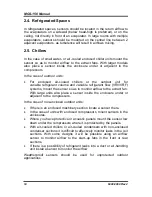
MGS-150 Manual
28
6309-9000 Rev 2
Step
Bump Testing Using Gas Ampoules
7
Tighten the wing-nut screw onto the ampoule until it shatters
allowing the gas to diffuse in the beaker. It should be left in
place for approximately 5 min.
8
The voltage output will increase. This confirms that the sensor
is responding. A response equivalent to at least 50% of the
test gas (typical) will confirm that the system is in order.
9
Remove the beaker from the sensor. Carefully remove any
ampoule remains from the gas detector and beaker.
Figure 10. Gas Ampoules for Bump Testing
6.3. Calibration Overview
There are two adjustments required: zero and span. They are monitored
at 0V and VS using a 0-5V scale. If the sensor range is 0-1000 ppm,
then 5V=1000 ppm.
Bacharach offers a calibration kit that consists of a calibration gas
cylinder, a flow regulation valve with flexible non-absorbent tubing and
vented calibration hood. Tools required:
•
Gas cylinder with the appropriate gas and concentration
•
A voltmeter (crocodile clips recommended)
•
Screwdriver (depending on housing).
The MGS has three sensor PCB versions: semiconductor (SC),
electrochemical (EC), and infrared (IR).
Summary of Contents for MGS-150
Page 10: ...MGS 150 Manual 10 6309 9000 Rev 2 Figure 2 EC or IR Sensor Components and Wiring...
Page 11: ...MGS 150 Manual 6309 9000 Rev 2 11 Figure 3 SC Sensor Components and Wiring...
Page 18: ...MGS 150 Manual 18 6309 9000 Rev 2 Figure 5 IP66 Housing with Splashguard...
Page 33: ...MGS 150 Manual 6309 9000 Rev 2 33...
Page 34: ...MGS 150 Manual 34 6309 9000 Rev 2...









































